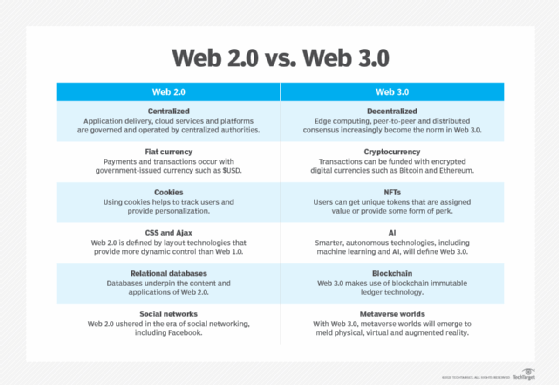The biggest advantages and disadvantages of Web 3.0
The benefits of next-generation Web 3.0 technologies like blockchain and smart contracts get much of the attention, but the downsides include complexity and resource intensiveness.
The web has undergone several evolutions in its history, starting in 1989 with Web 1.0, a collection of mostly static pages that nonetheless provided the initial foundation for the modern digital economy. Web 1.0 was followed a decade later by Web 2.0, which introduced more interactivity and dynamic elements.
Web 3.0 marks the next evolution of the web.
What is Web 3.0?
Web 3.0 is a term used to describe the third generation of the technology that enables the World Wide Web.
Web 3.0 is not a single standard, or even a set of standards. Rather, it encompasses a prevailing set of trends and technological approaches. For example, one of the initial components of Web 3.0, the Semantic Web, was first proposed in 1989 by Tim Berners-Lee, the inventor of the World Wide Web, as a way to build and manage relationships between the data on web pages.
Web 3.0 is also commonly associated with the concept of a decentralized web, where there is no central authority managing interactions. A cornerstone of the decentralized approach is the use of both distributed ledger technology and blockchain technology.
Web 3.0 also relies on related blockchain-based technologies, especially cryptocurrency, decentralized applications (dApps) and non-fungible tokens. Another aspect of Web 3.0 is broader use and integration of artificial intelligence in web operations.
This article is part of
What is Web 3.0 (Web3)? Definition, guide and history

Characteristics of Web 3.0
While there is no formal technical specification from a standards body such as the World Wide Web Consortium that defines Web 3.0, the following characteristics are usually attributed to Web 3.0:
- Decentralized network. Rather than relying on a single hosting provider, cloud or vendor, the basic idea behind a decentralized network is that there is no single authority that governs what can or can't happen. The promise of this decentralized approach is that it puts user data and freedom of choice at the forefront.
- Blockchain based. The decentralized nature of Web 3.0 is built on a blockchain foundation. Blockchain uses a theoretically immutable distributed ledger of transactions and activities that are cryptographically secured.
- Cryptocurrency enabled. On Web 2.0, most e-commerce has to be conducted with government-backed currency. For Web 3.0, crypto will be the preferred currency for conducting transactions for goods and services.
- Smart contract services. A key characteristic of Web 3.0 is services such as decentralized finance and dApps that are enabled by smart contracts. With smart contracts, services are governed by a policy defined in software code.
- Operational transparency. The mechanics of transactions on a blockchain allow for greater transparency. In addition, the rules defining how certain transactions occur are specified in smart contracts that are agreed to by members.
- User control. The decentralized architecture of Web 3.0 offers users the promise of more control over their data, which will typically be secured on the blockchain with both private key and public key cryptography.
- AI and machine learning. Increasingly, AI and machine learning (ML) are being built into the fabric of the web to make it more responsive and better able to anticipate and predict the needs and intentions of users. This kind of embedded intelligence is considered another defining characteristic of the emerging Web 3.0 landscape.
- Metaverse integration. More and more Web 3.0 technology is being intermingled with elements of the metaverse, a virtual space built on 3D graphics that is also seen as a key feature of the next-generation web. The metaverse and Web 3.0 have much in common, and their evolution goes hand in hand.
Advantages of Web 3.0
As with any technology, there are pros and cons to how Web 3.0 will affect the lives of web users and the internet as a whole.
What are the potential benefits of Web 3.0 for individuals and businesses? Broadly, Web 3.0 has numerous potential advantages that could impact the lives of users and bolster the digital economy in the years ahead.
Specific Web 3.0 advantages include the following:
- Control. With less lock-in risk than a centralized model, users have more control over their online identity and data.
- Transparency. Users have more transparency into how transactions occur and how decisions are made.
- Resilience. Improved resilience for application delivery results from the distributed nature of decentralized networks that don't rely on a central authority.
- Personalization. The Web 3.0 model can potentially enable more customization and personalization for online interactions.
- Predictive intelligence. Embedding AI and ML could make Web 3.0 "smarter" and more responsive to users than its predecessors.
- Privacy. The decentralized nature of Web 3.0 also provides potential privacy benefits to users that were not possible in prior generations of the web.
- Decentralized finance. The ability to conduct transactions -- including buying and selling products and services, as well as securing loans -- without the need for approval by a central authority will be an important benefit for many users of Web 3.0.
Disadvantages of Web 3.0
While Web 3.0 certainly has many positive attributes, it also comes with its own set of downsides and risks that must also be considered.
Among the cons of Web 3.0 are the following:
- Complexity. Web 3.0's reliance on blockchain, decentralized networks and smart contracts can make it significantly more complex for the average user to understand than Web 2.0.
- Security. The complexity of these foundational Web 3.0 technologies also makes it a nontrivial challenge for individual users to keep their activities secure, especially in light of widely reported cybersecurity incidents and a growing awareness of the many risks of blockchain applications and cryptocurrency exchanges.
- Regulatory concerns. The lack of a central authority makes Web 3.0 more difficult to regulate. As such, the regulatory and compliance regimes that help to keep online commerce and other web activities safe for users are simply not present -- and if they are present, they aren't effective.
- Technology requirements. The blockchains and distributed applications of Web 3.0 are often resource intensive, which means they won't run well, if at all, on older hardware.
- Lack of interoperability with Web 2.0. Web 2.0 is largely based on a centralized model, while Web 3.0 is decentralized, meaning web users are likely to continue using both versions for some time to continue benefitting from Web 2.0 applications.








